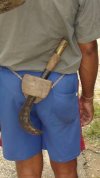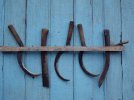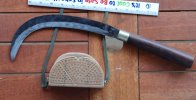Alright, let’s see what I can do to help you all out here.
A little background may be in order so you’ll understand where I’m coming from. I’m not a bushcrafty guy. I started out (and still am) primarily a sword guy. I collect and use modern production swords. If you’re not familiar with modern sword culture there are many “divisions”; I fall into the back yard cutter category. (Check out United Backyard Cutters on youtube or their forum or the Sword Buyers Guide forum if you want to know more about this topic.) What this means is I take my blades into the backyard and cut stuff up—“stuff” usually being water bottles, milk jugs, tatami mats, produce (pumpkins are hella fun!!) and other stuff that doesn’t fall into the category of sword abuse. The goal is fun and improving technique and appreciation of the blade. Along the way I fell in love with HI and the style they bring to the variety of blades they make. I have a couple kuks I use for yard work, but the rest of my HI blades are for cutting or simply appreciating.
I picked up my hasiya on the secondary market about 9 months ago, I think. I bought because I liked it, not because I thought it would be useful.
Length From one end to the other in a straight line it is about 14 inches.
Handle 5 5/8 inches including bolster and butt cap.
Thickness ¼ inch
Width varies but averages 1 ½ inches
Edge: Bevel starts about 1 inch from the spine and goes straight to the edge. There is a geometric formula that could give us the edge angle but I don’t want to bother looking it up.
Weight: 15.9 oz
The hasiya has a very obvious forward balance but because it isn’t very heavy it isn’t difficult to handle. It feels like a chopper rather than a slicer.
It has an eye on the end that came with a dangly brass curlicue kinda thing in it. I took this out when using it because it annoyed me.
It came paper cutting sharp. When I got it I tried it out on a few water bottles, some hedge (mostly thin branches no more than 1/4 inch in diameter) that I needed to cut back and a rose bush that needed pruning. I used it in a swinging/chopping motion with a wrist snap and it performed very well. My yard doesn’t have any of the thick grass type plants that I would normally think of as scythe cutting material.
That’s probably more and less than you were hoping for.

I’ll see what I can do about pictures and maybe putting it through a few paces this weekend.
Oh, yeah. Mine was made by Tirtha.









